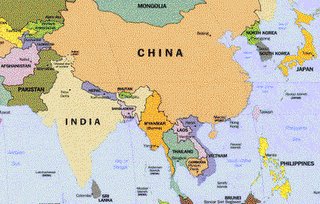It's not how big it is,...

I'm not sure how many constants there are, but one I'm sure of is that nothing stays the same: change is constant, even if the rate or direction of it is not. As has been pointed out too often, the main change agents in coming years are likely to come from the growth of China and India. (See, e.g., http://guambatstew.blogspot.com/2005/08/hear-no-evil-speak-no-evil-sino-evil.html, http://guambatstew.blogspot.com/2005/08/not-to-worry-budgy-bottom.html.) But we are reminded to keep a perspective, and don't get too far out in front of our anticipation:
"While there is no doubt about the great potential of these two economies in the rest of this century, severe structural and institutional problems will hobble them for years to come. At this point, the hype about the Indian economy
 seems patently premature, and the risks on the horizon for the Chinese polity – and hence for economic stability – highly underestimated.
seems patently premature, and the risks on the horizon for the Chinese polity – and hence for economic stability – highly underestimated."Both China and India are still desperately poor countries. Of the total of 2.3 billion people in these two countries, nearly 1.5 billion earn less than US$2 a day, according to World Bank calculations. Of course, the lifting of hundreds of millions of people above poverty in China has been historic. Thanks to repeated assertions in the international financial press, conventional wisdom now suggests that globalization is responsible for this feat. Yet a substantial part of China's decline in poverty since 1980 already happened by mid-1980s (largely as a result of agricultural growth), before the big strides in foreign trade and investment in the 1990s.
"Assertions about Indian poverty reduction primarily through trade liberalization are even shakier. In the nineties, the decade of major trade liberalization, the rate of decline in poverty by some aggregative estimates has, if anything, slowed down. In any case, India is as yet a minor player in world trade, contributing less than one percent of world exports. (China's share is about 6 percent.)
"What about the hordes of Indian software engineer
 s, call-center operators, and back-room programmers supposedly hollowing out white-collar jobs in rich countries? The total number of workers in all possible forms of IT-related jobs in India comes to less than a million workers – one-quarter of one percent of the Indian labor force. For all its Nobel Prizes and brilliant scholars and professionals, India is the largest single-country contributor to the pool of illiterate people in the world. Lifting them out of poverty and dead-end menial jobs will remain a Herculean task for decades to come.
s, call-center operators, and back-room programmers supposedly hollowing out white-collar jobs in rich countries? The total number of workers in all possible forms of IT-related jobs in India comes to less than a million workers – one-quarter of one percent of the Indian labor force. For all its Nobel Prizes and brilliant scholars and professionals, India is the largest single-country contributor to the pool of illiterate people in the world. Lifting them out of poverty and dead-end menial jobs will remain a Herculean task for decades to come."Even in China, now considered the manufacturing workshop of the world (though China's share in the worldwide manufacturing value-added is below 9 percent, less than half that of Japan or the United States), less than one-fifth of its labor force is employed in manufacturing, mining, and construction combined. In fact, China has lost tens of millions of manufacturing jobs since the mid-1990s. Nearly half of the country's labor force remains in agriculture (about 60 percent in India). As per acre productivity growth has stagnated, reabsorbing the hundreds of millions of peasants will remain a challenge in the foreseeable future for both countries. By most aggregative measures, capital is used much less efficiently in China than in India, even though in terms of physical infrastructure and progress in education and health, China is better poised for further economic growth. Commercial
 regulatory structures in both countries are still slow and heavy-handed. According to the World Bank, to start a business requires in India 71 days, in China 48 days (compared to 6 days in Singapore); enforcing debt contracts requires 425 days in India, 241 days in China (69 days in Singapore)."
regulatory structures in both countries are still slow and heavy-handed. According to the World Bank, to start a business requires in India 71 days, in China 48 days (compared to 6 days in Singapore); enforcing debt contracts requires 425 days in India, 241 days in China (69 days in Singapore)."This and more at: http://yaleglobal.yale.edu/display.article?id=6407
Nor should anyone overlook the potential for these two countries to turn their engines of growth into vehicles of competition and conflict. E.g., http://www.thehindubusinessline.com/2005/04/23/stories/2005042300310800.htm and http://www2.agsm.edu.au/agsm/web.nsf/Content/AGSMMagazine-CanIndiaRiseMatchChina
Labels: World economics

0 Comments:
Post a Comment
<< Home